Finding success in virtual selling amounts to solving one problem: How can you win and hold someone’s attention when every second something or someone else is vying for it?
And the answer is simple — show them something they actually care about.
But as with anything that’s so cut and dry, creating this kind of meaningful buyer engagement is a case of “easier said than done.”
Because adapting to virtual sales environments is difficult for buyers, too.
The real secret to buyer engagement? Leading with empathy.
Put yourself in buyers’ shoes — they’ve been tasked with finding a solution to solve a specific problem for their company, they spent hours or even days researching and reading different vendors’ websites to build their shortlist, and now they’re squeezing in a few sales meetings on top of all their other work.
During these meetings, they have coworkers emailing and messaging them on Slack or Teams, their dog is making noise in the other room, what they’re going to say in their next meeting is in the back (or front) of their mind, and amidst all that, they’re trying to find the difference in all these sales pitches they’re hearing which are starting to run together.
So as the seller, you’re not just competing with other vendors for the buyer’s attention — you’re competing with everything else in their world.
The most effective way to cut through the literal and figurative noise to engage buyers and win the business is to:
- First: listen and understand why they wanted this meeting at all. If you ignore this step, nothing else you do matters. A study from the Rain Group found only 26% of buyers believe sellers are good listeners and skilled at leading a specific needs discovery virtually.
- Keep every interaction focused on the buyer’s needs — because they’ll automatically tune out scripted pitches and vague fluff that doesn’t pertain to them.
- Provide quality content specific to the buyer's interests. Even better if it’s interactive and requires some action from them, as opposed to a television or lecture experience that switches them into a disengaged, listening mode.
- Constantly measure the buyer’s engagement so if their attention starts to wander you can rein it back in.
How is it possible to do all this?
Let's examine 3 common challenges to meaningful buyer engagement you can overcome with interactive content and experiences:
Challenge #1: Customer distraction during video meetings.
Video fatigue is a real issue for anyone in the business world today.
With almost every interaction being computer screen to computer screen, we easily become bored and distracted. When data shows that more than half of workers are doing other things during video calls, we need to be certain to garner interest and attention.
As a seller, you risk losing the buyer’s attention in virtual meetings a few ways:
- Technical issues with the meeting software, such as requiring buyers to download and navigate around a tool they haven’t used before.
- Problems with sharing your screen. Maybe you accidentally share something unrelated to the meeting, like a recipe you were Googling or confidential “behind the curtain” company information.
- Content that’s boring, doesn’t match what they’ve seen on your website, or unrelated to their interests.
- Lecture style presentations that set buyers up in a listening role as opposed to starting a dialogue.
The solution: Use a good meeting tool that cuts down on distractions, enables interactive content, and measures engagement.
Cutting down on distractions
To sidestep these issues and host productive, insightful virtual sales calls and presentations, the first step is to keep it simple when it comes to tech.
Use a meeting tool that doesn’t ask too much of the buyer — after all, they are the “guest” in this scenario.
A meeting tool that only requires a buyer to click a link is ideal.
You also want to cut down on any extra distractions, like issues with screen sharing or showing the buyer something they shouldn’t or wouldn’t want to see — like your talk track for the meeting, messaging from two years ago that’s different from what they just heard in a webinar your marketing team hosting, or your calendar showing your upcoming dentist appointment.
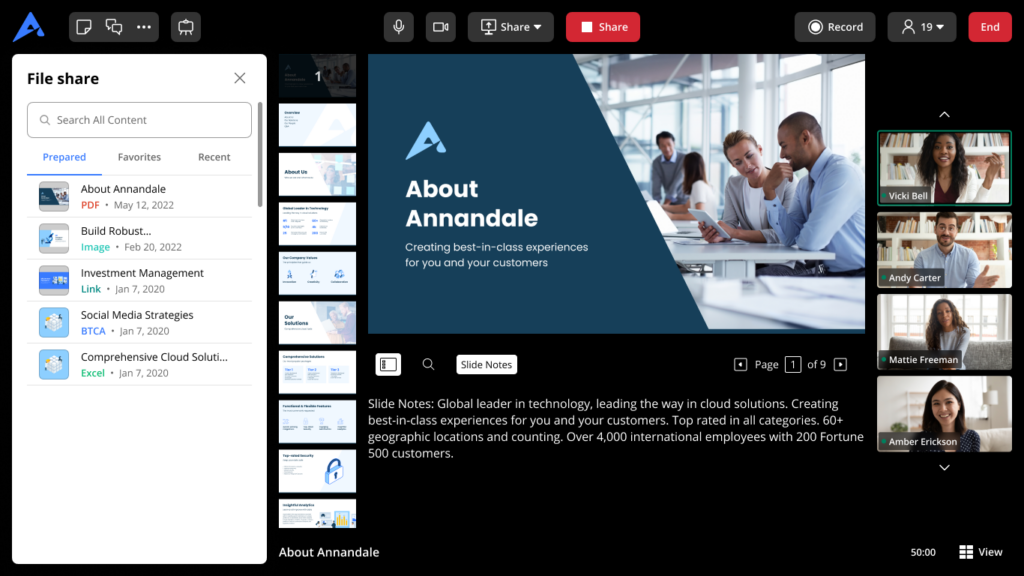
Pictured: File sharing and seller view in Bigtincan Meetings
Make sure to prepare your marketing-approved content that you plan to present ahead of time and close all other windows and tabs. But using a meeting tool that doesn’t require you to share your screen at all eliminates even this worry.
Enabling interactive content
Enabling interactivity in meetings lets the buyer both participate in and drive the conversation when they find something about your presentation they want to explore in more depth.
You can deploy interactive content like nonlinear, clickable presentations that allow buyers to control animations and dive into details that interest them, or even make the meeting itself more interactive with built-in tools like whiteboards that go beyond traditional “the seller pitches and the buyer listens” types of sales calls.
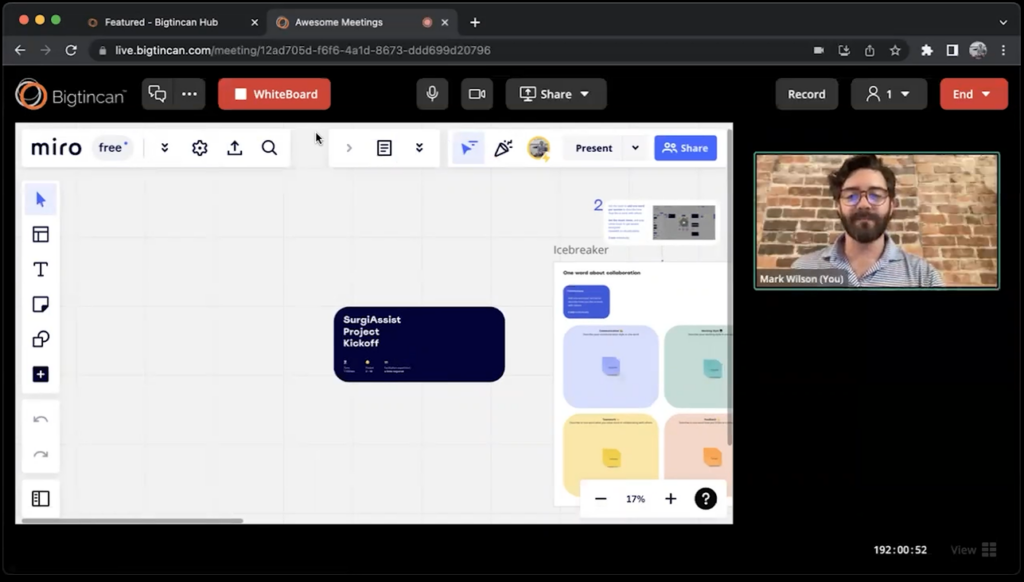
Pictured: Bigtincan Meetings with WhiteBoard
Mutual engagement helps the seller understand what their buyer is seeking, but it also keeps the buyer engaged in what the seller is sharing throughout the meeting.
Measuring engagement
And most importantly, a tool that can detect when a buyer’s attention is on the screen (when the Meeting window is primary and active) and capture those engagement analytics lets you know when they were paying the most attention, so you can learn which content or parts of the conversation was relevant to them.
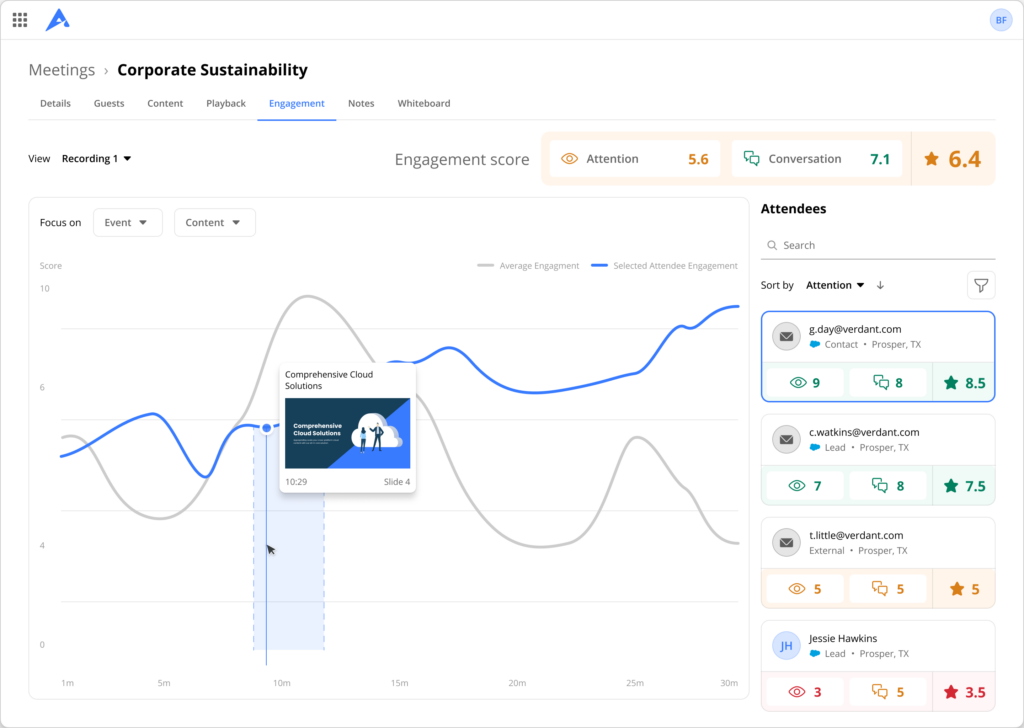
Pictured: Bigtincan Meetings Engagement Analytics
Challenge #2: Keeping track of meeting discussions, follow-up + relationship building.
We've all been part of productive meetings only to find that nobody recorded the action items or forgot key points, requiring the seller to rewatch the call recording (if it’s available) to log the notes, which stalls progress.
But sellers can’t be focused on note taking during the discussion if they want to keep buyers engaged, and the notes taken during the meeting can’t be thrown away, either — they make for engaging and relevant post-meeting follow-up to ensure that both parties are always on the same page throughout the sales process.
And consistent, fluid interaction between both parties helps build a relationship, leading to successful outcomes.
The solution: Make call logs and follow up easier by reducing administrative tasks.
People have mixed feelings about AI when it comes to the buying experience (and they’re right to), but one undeniable boon of modern sales technology is automation that reduces the digital “paperwork” slowing us down and impacting communication.
Some Conversation Intelligence tools let you record, transcribe, and automatically log meetings to your CRM with an AI-generated meeting summary — as well as next steps.
They also offer insights that help you improve buyer engagement and relationships.
In Bigtincan, for example, recordings are analyzed for indicators of successful or unsuccessful calls, including percentage time speaking across participants, total questions asked, total conversation switches, and individual scores for pace, clarity, use of filler words, and positive and negative tones of voice.
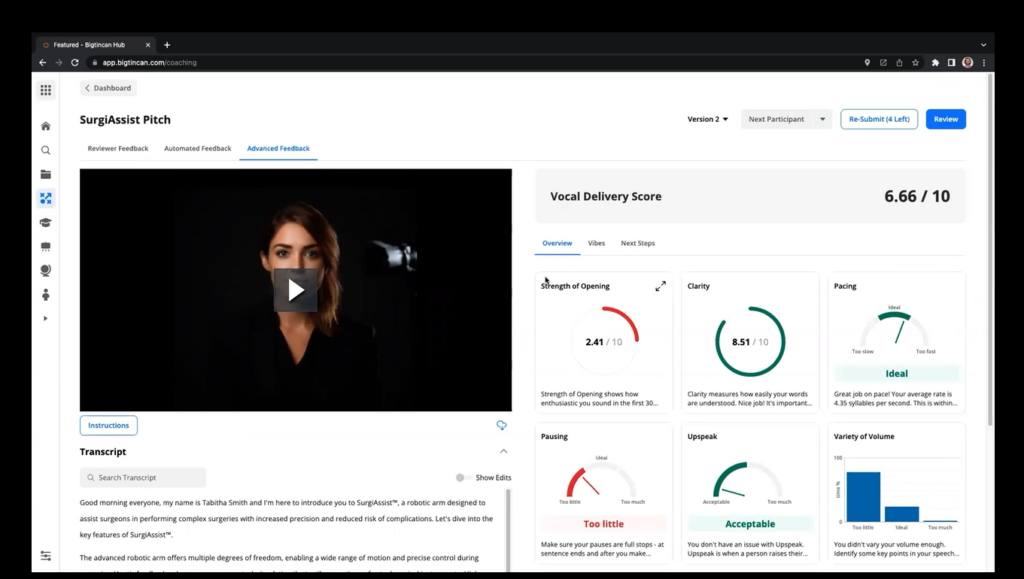
Pictured: Bigtincan Coaching AI with Conversation Intelligence
Sellers can then review their calls and self-coach from the AI-driven analysis to help themselves transform how they’re perceived by their audience.
And when sellers can spend less time on administrative tasks like logging notes in the CRM, they’re freed up to focus their time and energy on keeping buyers engaged.
See also: How AI-powered sales coaching improves your pitch
Challenge #3: Keeping a system of record for engagement with the customer.
When sellers share significant amounts of information with a buyer, it's challenging to keep track of everything.
The solution: Simplify content engagement for sellers and buyers.
Digital Sales Rooms (DSRs) are the perfect solution to bring buying committees together to collaborate and serve as the system of record across the buying process.
DSRs also provide instant access to their sales rep and a digital discussion thread tracks conversations, questions, and answers throughout the buying process.
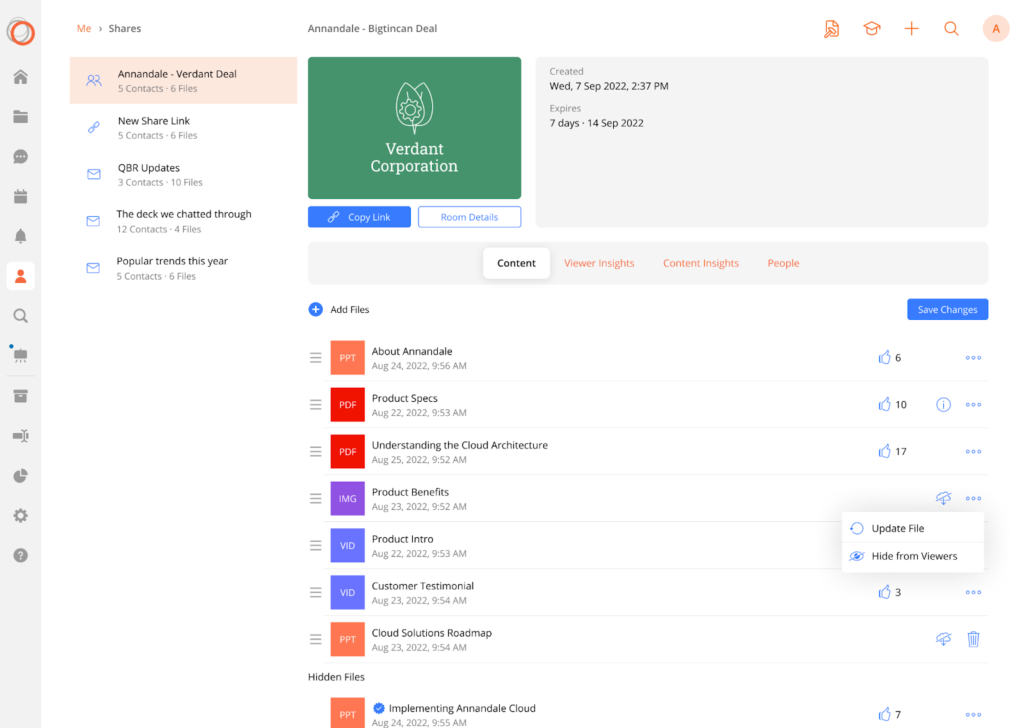
Pictured: Bigtincan Digital Sales Room with Engagement Data
DSRs provide easy access to content such as use cases, product brochures, demos, whitepapers, ROI calculations, and more.
This simplifies buyer engagement from a single location rather than buyers aimlessly searching through an email inbox to locate shared resources.
Whenever a member of the buying committee views content or posts a comment or question, the rep receives an alert notifying them so they can not only see which content and products interest the buyer, they can respond quickly to avoid any radio silence that leads to disengagement.
Meaningful buyer engagement is critical for sales growth
With the realized reduction in office and travel costs and the increased productivity from working remotely, virtual sales processes have become the norm.
So the struggle to continuously garner a buyer's attention amidst flashing ads, noisy notifications, and overcrowded inboxes is real.
Sellers who can quickly adapt and master the tools available to them in this environment, including modern meeting tools, interactive presentations, admin automation, and DSRs position themselves for success in achieving sales growth goals.
